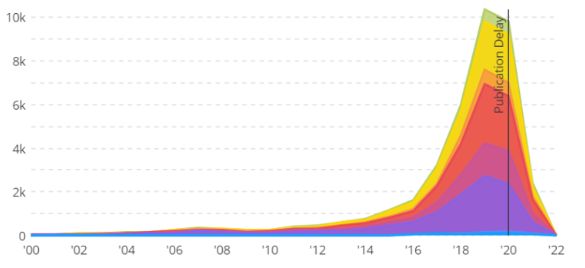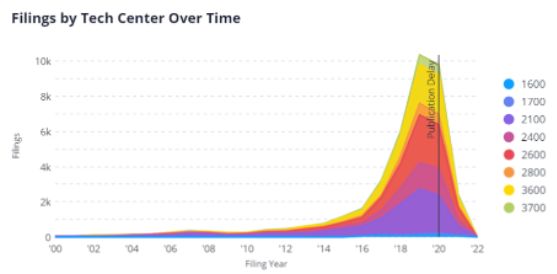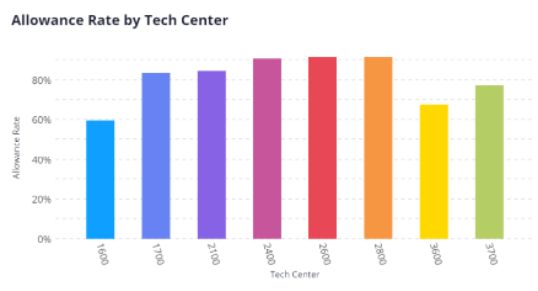
PatentNext Summary: Artificial Intelligence (AI) Patent Application filings continue their explosive growth trend at the U.S. Patent Office (USPTO). At the end of 2020, the USPTO published a report finding an exponential increase in the number of patent application filings from 2002 to 2018. This trend has continued. In addition, current data shows that AI-related application filings pertaining to graphics and imaging are taking the lead over AI modeling and simulation applications.
In the last quarter of 2020, the United States Patent and Trademark Office (USPTO) reported that patent filings for Artificial Intelligence (AI) related inventions more than doubled from 2002 to 2018. See Office of the Chief Economist, Inventing AI: Tracking The Diffusion Of Artificial Intelligence With Patents, IP DATA HIGHLIGHTS No. 5 (Oct. 2020).
Since the publication of the USPTO's report almost two years ago, AI patent application filings have continued their explosive growth trend.
The below chart shows filings by Technology ("Tech") Center over time from 2000 to 2022.

Note that the right-most side of the graph slopes down because of the 18-month "Publication Delay," during which information for newer patent application filings is not yet publicly available. See 37 CFR § 1.211.
The above chart organizes patent application filings by Tech Center. As shown, most AI-related patent applications fall into one of two Tech Centers. First, Tech Center 2100 (purple color in the above graph) includes examiners that handle "Computer Architecture and Software" inventions. It is not surprising that many AI-related patent applications end up here because Tech Center 2100 includes the specific AI-related Art Unit 2120, which handles technology involving "AI & Simulation/Modeling."
Second, Tech Center 2600 (red color in the above graph) handles "Communications" technology. Tech Center 2600 includes several art units devoted to graphic and visual processing, such as Art Unit 2615 ("Computer Graphic Processing") and Art Unit 2660 ("Digital Cameras; Image Analysis; Applications; pattern Recognition; Color and Compression; Enhancement and Transformation"). Such Art Units handle AI-related patent applications that involve image processing. This can include the use of a Convolutional Neural Network ("CNN") to detect, classify, and/or predict objects in two-dimensional (2D) and three-dimensional (3D) space.
Together these two Tech Centers receive a majority of the AI-related patent application filings.
For example, during the year 2018, Tech Center 2100 saw 1,733 filings, and Tech Center 2600 saw 1,416 filings.
Later, in the year 2020, these two centers still saw the most filings but were reversed in respective rankings as to the number of filings, where Tech Center 2100 saw 2,152 filings, and Tech Center 2600 saw 2,542 filings.
This suggests that graphical or image-related AI patent application filings have overtaken non-graphical or non-image AI-related filings by the year 2020.
As good news for AI inventors, these two Tech Centers experience high percentages of allowance. The below chart shows the patent application allowance rate by Tech Center.

As shown above, AI-related patent applications handled by Tech Center 2100 (purple bar in the above graph) has a relatively high allowance rate (84%). AI-related patent applications handled by Tech Center 2600 (red bar in the above graph) has an even higher allowance rate (91%).
This finding can be contrasted to Tech Center 3600 (yellow bar in the above graph), which handles patent applications for a mix of business-related technologies, i.e.: "Transportation, Construction, Electronic Commerce, Agriculture, National Security and License and Review."
Certain art units of Tech Center 3600, such as Art Unit 3620 ("Business Methods"), are infamous for issuing patent-eligibility rejections pursuant to 35 § USC 101. Such rejections can be difficult to overcome and explains the much lower allowance rate of 67% for Tech Center 3600.
Accordingly, staying out of Tech Center 3600 remains a viable strategy for patentees.
To the extent the reader is interested in accomplishing this, please see PatentNext's articles on best practices for patenting AI inventions. See How to Patent an Artificial Intelligence (AI) Invention: Guidance from the U.S. Patent Office (USPTO) and How to Patent Software Inventions: Show an "Improvement."
The content of this article is intended to provide a general guide to the subject matter. Specialist advice should be sought about your specific circumstances.


